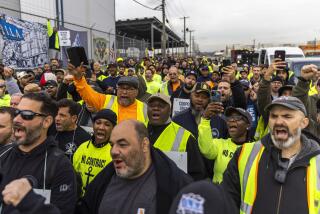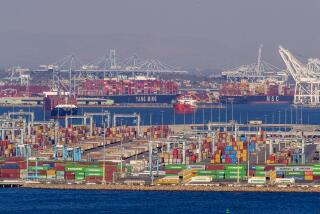Shipyard Closing Reflects Decline of a U.S. Industry
- Share via
QUINCY, Mass. — J. Paul Solander grew up in Quincy and started working as a ship pipefitter when he was 18 and the 180-acre shipyard was in its heyday. It had just cranked out 227 Navy ships of all sizes and types during World War II.
When the announcement came last month that the 101-year-old yard would shut down and 4,200 workers would be laid off by next year, Solander found himself job hunting for the first time in 37 years.
“It was a shock and a surprise,” Solander, 55, said of the closing as he visited an employment center.
Industry analysts say the decision by General Dynamics to close the plant that it purchased 21 years ago is not at all surprising. It’s only the most recent example of the steady decline of shipbuilding in the United States, they add.
4,000 Have Lost Jobs
In the past four years, 25 of the nation’s 110 shipyards have shut down, and up to 35 more are expected to close by the end of the decade. More than 20,000 workers have lost their jobs over the past four years and thousands more are expected to lose theirs, said Jed Babbin, vice president and general counsel of the Shipbuilders Council of America.
In the last two years, more than 4,000 workers in Puget Sound-area shipyards have lost their jobs. About 2,400 workers have been laid off in the last year at Todd Shipyards in San Pedro.
At Bath Iron Works in Maine, 4,500 workers are on strike after rejecting wage concessions that management said were needed because of the industry’s slump.
“There’s a worldwide economic slowdown,” said Harry Cook, president of National Waterways Conference. “Shipping suffers as a result of slower consumption.”
South Korea, Japan Biggest
The decline of the U.S. shipbuilding industry is blamed on many factors, but industry critics and boosters alike agree on the decreased defense allocations, lack of government subsidies and foreign competition.
Thirty years ago, U.S. shipyards built most of the world’s fleets. Today, South Korea and Japan, which ordered Quincy-built submarines for its 1904-05 conflict with Russia, build more than three-fourths of the world’s ships.
“It’s very difficult if not impossible for U.S. shipyards to compete with foreign shipyards,” adds Rex Sherman of the American Assn. of Port Authorities.
The International Trade Commission said in an April report that South Korea and Japan can build the same commercial ship twice as fast as any American shipyard at half the cost.
Babbin said Korean ship workers are paid $2 an hour while American ship workers average about $11 an hour. The Korean government also offers favorable financial terms to companies that build there.
Given the Far East’s dominance in shipbuilding, some foreign governments have tried to protect their shipbuilding industries through subsidies.
However, the Reagan Administration in 1981 eliminated a federal program that subsidized companies for half of the cost of building a commercial ship.
In addition, analysts say, the Reagan Administration’s military buildup has slowed, with Navy shipbuilding schedules calling for fewer ships.
Earlier this year, the Navy said it would reduce the work force at the nation’s eight government-owned shipyards by 5,000.
“American shipyards just cannot compete without subsidies,” Sherman said. “Without subsidies and without Navy work, you’re in trouble.”
Emphasizing that American shipyards are the world’s leader in construction of combat ships, Babbin said the closing of American shipyards, such as the one at Quincy, affects more than the economic prosperity of workers and cities. It also affects national security, he said.
“The loss of Quincy is a major reduction in the size of the mobilization base and our capability of meeting wartime demand,” Babbin said.
Richard Piccuito, president of Shipbuilders Local No. 5 in Quincy, agrees.
“The American shipbuilding industry is going down the tubes,” Piccuito said. “And if we ever have a problem with our national defense . . . how are we going to man the seas if we can’t build the ships?”
Piccuito, a sheet metal worker who has worked at the Quincy yard for 30 years, said the union plans to send a contingent to Washington to seek government help.
More to Read
Inside the business of entertainment
The Wide Shot brings you news, analysis and insights on everything from streaming wars to production — and what it all means for the future.
You may occasionally receive promotional content from the Los Angeles Times.










